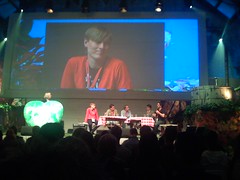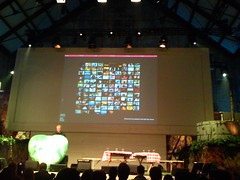PICNIC07: Andrew Keen, author of Cult of the Amateur
September 27, 2007 | CommentsPICNIC07: Andrew Keen, author of Cult of the Amateur
This is in response to David Weinberger's earlier talk.
Andrew: David is a philosopher and marketer; his talk was a philosopher selling the web in a seductive way. I don't agree with a lot of what he said. The issue we disagree with on complexity; he says "we want more complexity; complexity is interesting".
He's mixing media with the world; what he wants is for media to reflect the world, but I don't think it should. Media shouldn't trivialise the world, but communicate it in a way we all understand; the Internet today doesn't do this, it creates complexity and confusion. The job of gatekeepers in traditional media is to simplify things. Do you think media should reflect the world?
Talent is scarce, as are resources. Good journalists have both the ability to do their job, and the ability to devote their time to it. Amateurs don't have this.
[...trailed into an interesting, but difficult-to-blog, argument...]
links for 2007-09-27
September 27, 2007 | Comments-
Whoops. "In the meantime, please use email to share photos with your friends," the company said.
PICNIC07: Panel, \"Up Close and Personal: Share your Life\"
September 26, 2007 | CommentsPICNIC07: Panel, "Up Close and Personal: Share your Life"
First up, Jyri of Jaiku with his personal take; references Brad Fitzpatrick on "the Social Graph" (posh name for social software, it seems). People are connected by objects, and we need to represent these objects somehow: e.g. delicious turns bookmarks into social objects, used to connect me to other people who've bookmarked the same places. Flickr turned photos into social objects, Youtube videos. We're going into activity streams that show what your friends are doing now with objects. Subject-verb-object. Social software promotes what I should be aware of around myself, in a virtual social space. Will we see a "facerank" algorithm analogous to "pagerank", and delivering similar benefits.
 Biz Stone on how Twitter started: Jack and he were working together, wanted to tie SMS and the web together and were intrigued about MSN status messages. Built a prototype in a couple of weeks, which was really fun to use. Twitter's being used for social activism: "censorship is the sincerest form of flattery". Example of an activist leaving micro-updates: dead easy, and even the lack of updates is in itself an indication of useful information.
Biz Stone on how Twitter started: Jack and he were working together, wanted to tie SMS and the web together and were intrigued about MSN status messages. Built a prototype in a couple of weeks, which was really fun to use. Twitter's being used for social activism: "censorship is the sincerest form of flattery". Example of an activist leaving micro-updates: dead easy, and even the lack of updates is in itself an indication of useful information.
Matt Biddulph of Dopplr: Dopplr users have so far travelled 89 million miles. There's serendipity in travel. (Dopplr==planned serendipity?). This gives some access to the things high-end travellers have: e.g. help from others.
Raymond Spanjard of HYves talks about how it put him in touch with transexuals seeking wigs :)
Jyri: "When your friends know what you're up to, you get magical powers".
Raymond: "the future of social networks is mobile".
Felix Petersen, Plazes: most people don't use social networks to hook up with strangers, but to keep track of existing friends in different contexts. There'll always be a need for one-to-one communication, but discovery and finding out what your best option is for social interaction precedes that.
Biz: putting APIs atop of SMS and the like is empowering for the third world.
Talking about how each panelists network interoperates with other networks: "why are you witholding happiness from each of us?"
Jyri: lots of services don't share social networks, because we haven't had the means to do it. It's not due to lack of will; we're getting to a phase of Web 2.0 where we're coming up with useful standards: OpenID, XMPP to push out information (instead of pulling RSS). Jaiku lets you pull your updates from other services by RSS.
Biz: we created an API early on. We see 20x traffic via API than via web site.
Raymond: blah blah integrate flickr photos blah.
Felix: flannels, I feel :)
Matt: Dopplr are specialist, some people say that it feels like a feature of a larger system. We say "yes, the Internet". Dopplr works best with other systems: "what did I twitter from SF"? Dopplr should appear amongst other services, you should never need to go to the site. We've launched Facebook, import social graph from twitter, and the ability to dump data out from the API, not just get it in. Dopplr is fun and interesting (and has no memory until 1.0), but may get mixed with other sites.
Moderator invites the panel to ask each other difficult questions.
Jyri: Biz, will Twitter ever support photos?
Biz: Not sure, we're not against the idea but love the simple 140-char format. Possibly but there's no timetable.
Matt: Jyri: do you regret starting out making mobile clients?
Jyri: no. Platform plays are easier as it avoids the problem of distribution. Will mobile be ready for rich applications, or will we be stuck with SMS? We'll probably have pockets of more advanced mobile devices (e.g. Nokias), operators have cut data rates, etc. But for global reach you're stuck with lowest common denominator like Twitter.
Jyri, Matt: how does doing a travel site square with the ecological impact of it?
Matt: serendipity allows people to optimise their trips. One problem with carbon offsetting programs out there at the moment is that they don't know where you've been - we do.
Moderator: one thing that struck we watching Twittervision is that it gives you the sense of everyone experiencing the same range of mundane and profound experiences and emotions.
PICNIC07: Jonathan Harris of We Feel Fine
September 26, 2007 | CommentsPICNIC07: Jonathan Harris of We Feel Fine
 First movement: gathered sentiments from weblogs with an automated search, plots them onto a screen as moving dots, and implements clustering behaviour between them.
First movement: gathered sentiments from weblogs with an automated search, plots them onto a screen as moving dots, and implements clustering behaviour between them.
Second movement: gathered photos from these blog posts and mixes them with the sentiment.
Third movement: feeling breakdown of the overall population (most people feel "better" apparently). Also a gender breakdown (women slightly more prolific than men in blogging).
Fourth movement: plotting weather conditions at time-of-post and use this to implement behaviour of sentiments.
Fifth movement: statistical view.
Sixth movement: visualisation as gelatinous blobs.
Oodles of lovely data, categorised and related.
Passive observation leads to candid findings, because people don't know they're being watched.
New project, Universe: "is there a mythology we hold, as a species, today?" Is there a set of global stories affecting all our lives? Think about a new metaphor for organising information, beyond the web page - based on relationships.
A lot of his projects involve setting up simple rules, and running them over time (e.g. "gather all web pages including the phrase 'I feel'"). In Spring he subjected himself to the same sorts of rules his programmes follow - which led to The Whale Hunt. Jonathan decided to photograph the entire experience of living with an eskimo family hunting a whale at 5 minute intervals - even when sleeping (using a timer to take pictures). When exciting things happened he'd quicken the pace of photography, producing a sequence of images matching the pace of his heartbeat: 3214 pictures over 7 days.
Graphs excitement level over 7 day period, using intervals between photos to gauge excitement.
Also wanted to experiment with a new interface for human storytelling: taking an epic experience, documenting it, and looking for sub-stories. Filters on the photos let him whittle down pics by character, activity and themes.
PICNIC07: Blaise Aguera Y Arcas, Microsoft Live labs
September 26, 2007 | CommentsPICNIC07: Blaise Aguera Y Arcas, Microsoft Live labs
Showing off a couple of things:
Firstly Seadragon, a client/server image manipulation package. Shows demo of hundreds of photos on-screen, including some extremely high-res (300 megapixel) ones. It's all about taking the idea of multi-resolution and generalising it to the web. "These images are small: those are FAR AWAY...": you don't need to see all of an image to view it from a distance. The client tells the server what it needs to see, so arbitrary objects can be interacted with over even moderate bandwidth. Demos zooming into the entire text of Bleak House.
(Interesting, a lovely visual demo and a great demonstration of zooming between levels of scale... but where's the rocket science here? Isn't this the sort of thing Google Earth has been demonstrating for a while?)
Shows demo of multi-resolution advertising, where you zoom into details of tech specs of a car. Reminds me of those TV ads which broadcast recipes you had to read by recording to VHS and playing back slowly.
(Ah, the difference between this and conventional mapping software is that the latter usually moves between discrete layers of magnification, whilst Seadragon doesn't)
Phototourism: taking photos and showing the relationships between them. Shows a set of photos taken in St Mark's Square, Venice; you can zoom in and out of the image and see great levels of detail. Relationships between the photos have been inferred, and features common to them have been related between photos, then plotted in 3D space. Shows a nice demo of scanning around a 360 degree view using photos pasted together. Shows a camera-view showing where photographers were when every photo was taken.
(I'm not clear how much of a manual process it is to take these photos and plot them in 3D space)
Shows a demo of photos from Flickr, all of Notre Dame cathedral. Shows placement of all the cameras used to take these photos - these were all done by individual people. From this set of photos they build up a 3D zoomable reconstruction of the cathedral.
There are not many cities on earth where we have enough photos to reconstruct them; on the other hand top-down approaches to mapping can't scale up to the volume of visual information out there (or reach inside all buildings). Knitting together public spaces and views of the world with personal ones is the biggest promise of Photosynth.
Creating 3D environments out of video is easier than out of still images, thanks to close correlation between sequential frames. "Video painting", where you take a camera, sweep it across a space, and get a reconstruction out.
Imagine a shop using their physical environment as a basis for their virtual environment.
They haven't made any releases of Photosynth, and they're not ready to announce a date, "but it won't be long now".
Conference organiser points out that connecting photos together and that connecting interior to exterior raises significant privacy concerns.